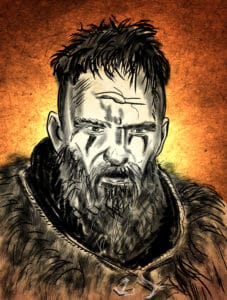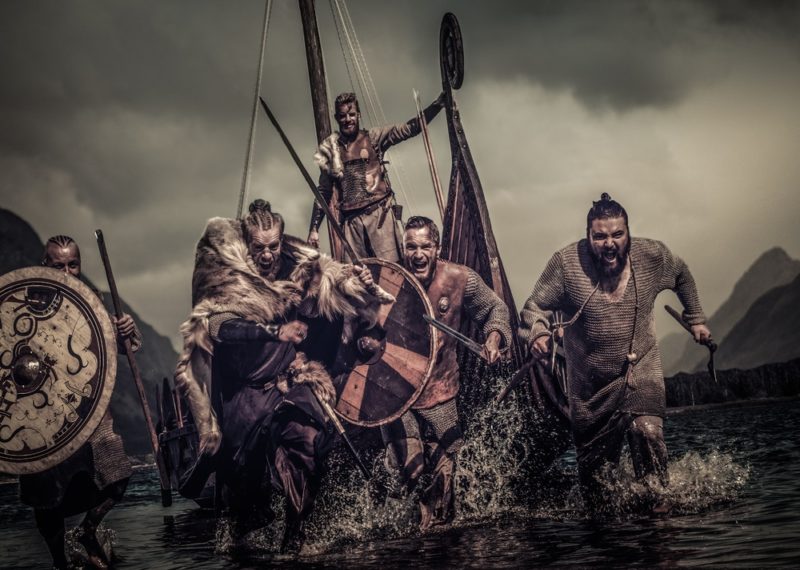Norse warriors are often depicted as ruthless, brave heroes in the Icelandic sagas. Among them was Ragnar Lothbrok, a particularly eminent Viking raider. He was also referred to as a Swedish and Danish king that led many Viking invasions.
Ragnar Lothbrok, also known as Ragnar Lodbrok, was a hero in Norse tradition that has been captivating historians and storytellers for decades. The legendary Viking leader has become known to today’s audience through the popular television series “Vikings,” yet there are still questions about his existence.
At the furthest depths of our past, in the murky dark fog that connects mythology and actual history, stands Ragnar Lothbrok. 350 years after his reported demise, the Icelandic skalds recorded his narrative, and many kings and rulers claim a connection to this most mysterious of Viking warriors.
The Saga of Ragnar Lodbrok

The Saga of Ragnar Lodbrok, written in Iceland in the 13th century and referred to in Old Norse as “Ragnars saga lobrókar,” is the most well-known and important source describing Ragnar’s life and valiant exploits.
It fits in perfectly with the surge of Icelandic saga literature that swept the land during this time. “Fornaldarsögur” are legendary sagas whose narratives occurred before Iceland was colonized from the 870s CE onward.
These heroic tales frequently involved the demise of their hero and traced their roots to the fabled origins of real-life Scandinavian lineages. The Saga of Ragnar Lodbrok portrays him as the ancestor of an Icelandic family, highlights the interactions between many kings, and, in keeping with the genre, concludes with his death.
Aslaug’s Early Years
Aslaug’s early years are depicted first in the narrative. She would eventually become Ragnar’s second wife. This maiden was the daughter of Brynhild and Sigurd, who passed away when Aslaug was only three years old. Brynhild is described as the mythical Valkyrie and dragonslayer from Germanic mythology who Wagner further popularized. Aslaug was then raised in Norway by a poor family that gave her the name Kráka (which means “crow”) and hid her origins.
Ragnar Becomes a Ruthless Warrior
Ragnar, the son of King Sigurd Ring, who was the King of Denmark, matured into a charming and skilled Viking warrior who was kind to his troops and ruthless to his adversaries. He is described as a legendary warrior that few could surpass. His first accomplishment was helping Herru, the jarl of Götaland, solve his problem with a dragon, a serpent that had outgrown its proper size in their town.
Ragnar Kills a Dragon and Marries Thora
He killed the dragon using a spear while wearing a new pair of shaggy trousers and a cloak that had been boiled in pitch. As payment, he was given the jarl’s daughter Thora’s hand in marriage. Ragnar married her, and they have two kids, Agnar and Eirek, before she became ill and passed away.
His Second Marriage
Lothbrok, who was devastated by Thora’s illness and death, decided to raid rather than rule once she died. One summer, he sails to Norway and finds Kráka’s farm by accident. When he discovered her beauty, he became eager to marry her and gave her a test of understanding, essentially a puzzle to solve, which she passed.
Ragnar’s Sons
They then have children – Hvitserk, Bjorn Ironside, Rognvald, and Ivar the Boneless, who is described as being boneless because of a curse set on Kráka. This curse would apply only if Ragnar were too eager on their wedding night. Ragnar believed Kráka to be a plain peasant girl all along, and he was ultimately persuaded to marry the daughter of a Swedish king.
Aslaug
Aslaug, who had since reclaimed her identity and lineage, informed Ragnar of this and used the prophecy that their upcoming son will have snake-indented eyes to support her claim. As a result, Sigurd Snake-in-the-Eye saved their union.
Due to unresolved issues with the Swedish King, whose daughter’s betrothal had unexpectedly ended, a sequence of events occurs. This included Aslaug renaming herself Randalin and bringing her sons along for the fight, Agnar and Eirek attempting to fight the Swedes but running into a mystical cow that defends the Swedish army. They were eventually successful at changing the tide.
The Viking Hero Dies
Ragnar made an arrogant vow to conquer England with only two ships at the end of the saga, but he later regrets it. He is later imprisoned by King Ælla of Northumbria and cast into a pit of snakes, where he is killed.
Ragnar’s Sons Get Revenge
Upon hearing the news of their father’s passing, Ragnar Lothbrok’s sons sought revenge, bringing their influence to England. According to this narrative, they allegedly executed King Ælla using a barbaric practice called the “blood eagle.”
The Tale of Ragnar’s Sons
The Tale of Ragnar’s Sons, which directly follows the narrative mentioned above, was recorded in Iceland sometime during the 13th or 14th century CE. It presents a larger Viking kingdom that extends to England, Norway, and the Baltic as an “enhancement” of The Saga of Ragnar Lodbrok.
The Son of King Hring
This is immediately clear at the beginning of the book when Ragnar is identified as the son of King Hring, who had colonies in Denmark and Sweden. He was the person Ragnar succeeded as ruler. This is also clear in the last few lines of text when it is revealed that Hring’s sons dominated various kingdoms in Sweden, England, Norway, the Baltic, Germany, and parts of Denmark.
With a few changed elements, summaries, exclusions, and the inclusion of a long extrapolation on the deeds of Ragnar Lothbrok’s sons after the Viking leader’s death, this narrative maintains most of the essential parts of The Saga of Ragnar Lothbrok.
Ragnar Described as a Danish King
Additionally, Ragnar Lothbrok is portrayed as the King of numerous countries and as a kind and benevolent ruler of his vassal kings. However, in this work, Iceland is completely excluded, which is odd, considering that it was written by an Icelander. In this work, Ragnar Lothbrok is the progenitor of only the Norwegian and Danish royal families.
Other Norse Sources
While Ragnar is mentioned frequently in some Old Norse writings, there are also more subtle references to his character in other Old Norse sources. He left his mark on two other Icelandic sagas, known as fornaldarsögur. We’ll discuss some of the most important sources in the section below.
Bósa Saga Ok Herrauðs
The Herraur is identified as the father of Ragnar Lothbrok’s first spouse, Thora, in the Bósa saga ok Herrauðs, recorded around 1300 CE.
Hálfdanar Saga Eysteinssonar
Moreover, the protagonist of the Hálfdanar Saga Eysteinssonar, a saga that dates back to the 14th century CE, is shown to be the great-great-grandson of Sigurd Snake-in-the-Eye, who was Ragnar’s son.
Bárðar Saga Snaefellsáss
Additionally, the character Raknarr from the Bárðar saga Snaefellsáss (probably written in the 14th century CE) is thought by some researchers to be Ragnar Lothbrok.
Norse Poems
In addition to the sagas, Ragnar Lothbrok is also mentioned in a number of poems:
Háttalykill
The Norse Poem Háttalykill, written in 1142 CE by an Icelander and an Orcadian jarl named Rögnvaldr kali Kolsson, also has hints of the Viking warrior. However, the portion of the poem that refers to Ragnar has only been preserved in parts. This means that it does not add much to the narrative apart from describing a boneless figure and suggesting that Ragnar might have met King Ælla.
Ragnarsdrápa
Ragnarsdrápa, which means “the poem about Ragnar,” stands out among other 13th to 14th-century poems about our hero. It was written by Bragi Boddason, who was a Norwegian poet. The shield was reportedly given to Bragi by a man called Ragnar, who is dubbed Ragnar Lothbrok in another poem. It depicts mythical events that had been painted or engraved on the shield.
This attribution has been questioned, though, as it might just as easily relate to another Ragnar in the future, and Ragnar Lothbrok’s questionable history does not support the idea that he had any personal interactions with the real Bragi.
Krákumál
The Death-Song of Ragnar Lothbrok, an English interpretation of Krákumál, which translates directly as “words of the crow,” focuses on one particular event in the Ragnar tale: his demise. This poem portrays itself to be Ragnar’s death song, created by the Viking warrior himself while he was preparing for his death.
It links to the widely known tale of Ragnar’s imprisonment by King Ælla. Ragnar probably didn’t write it, though. The poem’s vocabulary is that of the 12th century CE and not the 9th, when Ragnar would’ve lived. It also doesn’t contain the typical features of a Danish Viking.
Was Ragnar Lothbrok a Historical King?
Viking legend is full of mystical creatures and seemingly impossible events. While the Norse mythology makes for a captivating story, how much of the tale of the leader of the Great Heathen Army is actually based on historical facts?
The Icelandic Sagas and Other Sources Mention Mythical Creatures
With the exception of dragons and other blatantly fictitious aspects, it is challenging to say with certainty whether Ragnar Lothbrok was a real historical man. This is especially true when considering the sources’ contradictory accounts of him.
These Legends Were Recorded Many Years After They Supposedly Occurred
Furthermore, historical sources do not provide adequate coverage of the period in which these stories were recorded, the 9th century CE. Even though the stories themselves date back to the 12th century CE, their themes are much older than the tales themselves.
Many Norse Names Were Popular During the Viking Era
Since many Viking names were also fairly popular, identifying specific people was considerably more challenging. This means that there could have been more than one historical Ragnar Lothbrok, which is why the accounts differ.
The Seige of Paris and the Viking Invasion Are Based on Fact
Some 9th-century incidents, such as the blockade of Paris in 845 CE, as well as specific people, such as the English King Ælla of Northumbria, who ruled during 866 CE when a Viking invasion that affected the Anglo-Saxon kingdoms devastated the land, are factual. However, as far as we know, this invasion was not motivated by anyone desiring retribution for their father’s death outside the Ragnar tales.
Accounts in the Anglo-Saxon Chronicle
According to the Anglo-Saxon Chronicle, there are two Viking leaders of the army named Hubba and Hingwar, as well as a person named “Halfdene” mentioned in historical accounts. (Anglo-Saxon Chronicle for 870 and 871 CE).
The Chronicle also mentions King Ælla’s actual demise: he is supposed to have been killed in combat with Viking warriors at York in 867 CE, with no reference to the horrifying blood-eagle execution popularized by the Ragnar narrative. Although modern chronicles are completely silent on the issue, they have frequently been linked to Ragnar’s sons Ubba and Ivar the Boneless, with “Halfdan” or “Halfdene” potentially standing in for the Hvitserk of the Old Norse myth.
The Saga of Ragnar Lothbrok Was Likely a Combination of Numerous Unrelated Historical Figures and Events

As far as we are aware, no historical figure matched Ragnar’s supposed actions to an adequate degree. It is more likely that tales emerged to bring together numerous past events and well-known figures in the ages after the bold Viking era of invasions in the 9th century.
A number of scholars have proposed that Ragnar Lothbrok may be a composite of different real persons, bound together into one fabled warrior who was the bane of northern Europe in the 9th century CE and the father of numerous renowned sons. The historical persons who came to be regarded as Ragnar’s sons may have been well-known enough to claim such noble ancestry.
Possible Historical Figures
Contenders who might have been humble enough to be portrayed as Ragnar Lodbrok in heroic tales include:
- Danish King Horik I (r. 827-854 CE), who led the raid of the Frankish territories of Louis the Pious
- King Reginfrid of Denmark, mentioned in Danish history
- Viking chieftain Reginherus, who raided Paris in 845 CE
- A Norse leader of the Anglo-Saxon invasion in 865 CE
- The Raghnall who is mentioned in Irish Annals
- Frankish King Charles who played a part in the siege of Paris
Final Thoughts
Ragnar Lodbrok is described as a tenacious leader of the Great Heathen Army. He sailed the Irish sea and invaded several nations. According to Icelandic sagas, he was one of the slain Viking warriors who died at the hands of King Ælla. Whether or not the story of this hero is indeed true or not, however, is left to your interpretation.
Frequently Asked Questions
In the section below, we’ll take a look at some of the most commonly asked questions about Ragnar Lothbrok.
1. Were Ragnar Lothbrok’s Sons Historical Figures?
While it can be challenging to confirm the legendary tales of Lothbrok, there is evidence suggesting that his sons may have been actual historical people. Since many of them lived in the same areas and at the same periods as the references made to them, there is more proof supporting their credibility than there is for Lothbrok. The sons provided additional historical background for Lothbrok by claiming to be his biological children.
It is known that a Viking raider by the name of Bjorn, most likely Bjorn Ironside, an expert naval leader, attacked the Paris region between 857 and 859. Ubbe and Ivar the Boneless were also among the “Great Heathen Army’s” commanders.
William of Jumièges, a Norman historian, mentioned Bjorn Ironside in 1070 and identified a Danish monarch called “Lothbrok” as Bjorn’s biological father. Ivar the Boneless was mentioned by historian Adam of Bremen as another one of Lockbroth’s sons a few years later. The identity of the Ragnar Lothbrok mentioned in these texts is unknown, though.
2. Why Was Ragnar Given the Nickname “Shaggy Breeches?
In order to gain his second wife Thora’s hand in marriage, Ragnar is said to have boiled his cowhide trousers in pitch, which he believed shielded him from the dragon. This is how he earned the nickname “Shaggy Breeches.”
3. How Many Wives Did Lothbrok Have?
According to the sagas, Ragnar had three wives. According to Norse legend, Ragnar had to kill a monstrous serpent in order to win his first wife, Thora. When he sought revenge for the death of Fro, his grandfather, in Norway, Lagertha, a Scandinavian shield maiden, battled beside him. She finally became his wife, despite supposedly once assaulting him with a bear and hound that protected her household.
Aslaug, his third wife, was rumored to be the offspring of Brynhildr, a shield maiden, and Sigurd. During their engagement, Ragnar offered her a puzzle and impressed by her insightful answer, soon after proposed to her.
4. Why Were There Debates Over His Death?
After a series of attacks in England, our hero was finally apprehended by the Anglo-Saxon King and imprisoned there until his death. It is believed that he said, “How the little piglets would grunt if they knew how the old boar suffers,” while he was dying, foreshadowing the vengeance his sons would exact. He is also claimed to have thought back on earlier battles and anticipated attending the Valhalla, a vast banquet hall for warriors who had died when they passed on.
However, other scholars contend that Lothbrok perished between 852 and 856 CE in a storm while plundering the Irish sea, despite the fact that this tale is also told in subsequent Icelandic texts.


